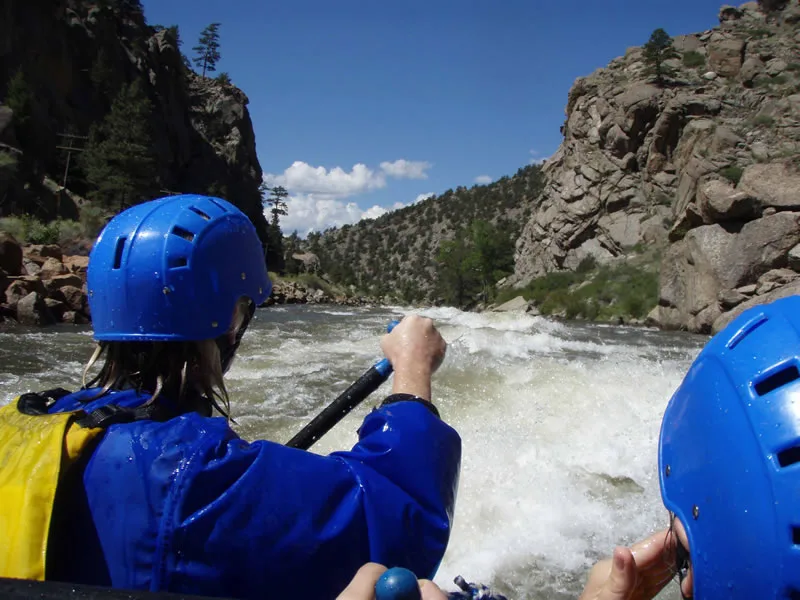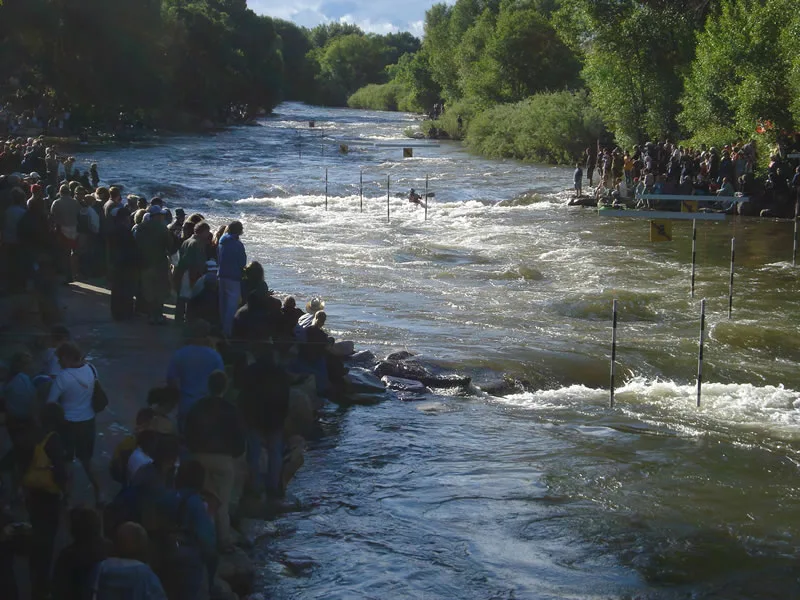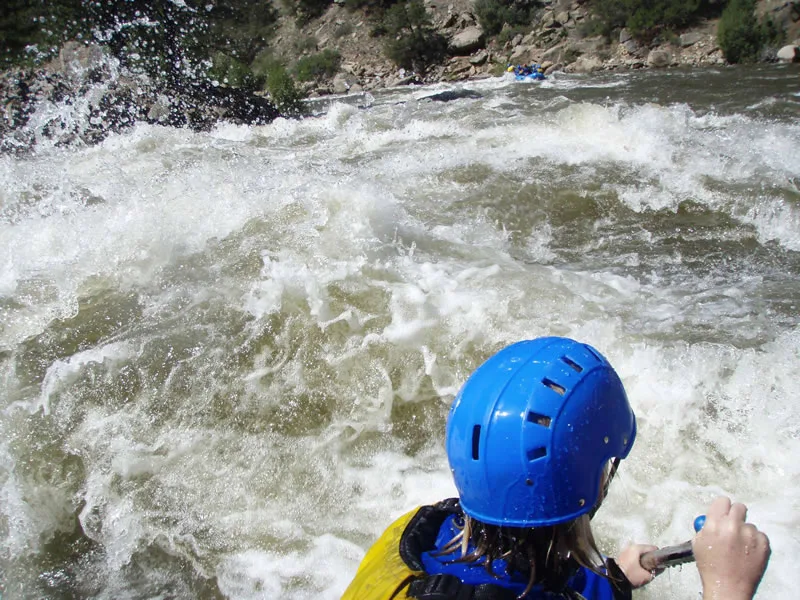Deep in the heart of land-locked Colorado sits the watersports town of Salida and a river known for its world-class rafting, the Arkansas River. The Arkansas Headwaters Recreation Area is 148 miles of riverpark providing a challenging playground for rafters and kayakers.
Colorado is the land of sinfully good white water and the Arkansas is the best of the best when it comes to rafting and kayaking. Flowing 150 miles from the old mining town of Climax in Lake County east through Colorado, the Arkansas provides some of the most awesome whitewater experiences in the country.
The Arkansas River is highly valued for its diverse recreation and is used by more than 500,000 rafters, kayakers, anglers, campers, and wildlife viewers each year. Of all these activities, the most dramatic is rafting its spectacular whitewater.
Rafting trips vary in difficulty and length, allowing quite a bit of flexibility in planning that special vacation trip. There are hundreds of access sites, but the most popular are located at Granite, Buena Vista, Fisherman’s Bridge, Ruby Mountain, Hecla Junction, Stone Bridge, Big Bend, Salida, Rancor, Vallie Bridge, Lone Pine, Pinnacle Rock, Spikebuck, Parkdale, and Cañon City.

The internationally renowned NumbersRapids lie a short distance north of Buena Vista, with views to the west of the Collegiate Peaks. These are world- class kayaking waters. The river continues through narrow Brown’s Canyon where it veers away from the highway and runs alongside a railroad. Its remote character and quality rapids make this the most popular segment of the Arkansas River. Further down, 1,000-foot sheer rock walls of the Royal Gorge tower above the river as it flows into Cañon City. Rapids such as Sunshine Falls and Sledgehammer make running this stretch an adventure.
High elevation with a rather steep drop through the lower valley, combined with snowmelt from the surrounding mountains, makes for a memorable ride down the river. During the spring runoff when the river is full of freshly melted snow the temperature of the water is especially cold. Warm days and cool to freezing nights can be expected in the mountains during the summer, and thus the river remains relatively cold. July and August are usually the warmest months. During this time, afternoon thunderstorms are common. Be prepared for both warm and chilly weather, as well as for rain showers. Proper dress when participating in whitewater sports is essential. Wear shoes that can protect your feet should you unexpectedly “go for a swim” and bounce off rocks or need to walk out of a canyon in the event of an accident. Wet suits are mandatory when air and water temperature added together total 100 degrees or less. If this total is less than 80 degrees, a full set of waterproof or wool garments on top of the wet suit should be worn. To best prepare for a rafting experience, boaters should assess their own abilities and equipment in relation to the International Scale of River Difficulty.
If rapids on a river generally fit into one of the following classifications, but the water temperature is below 50 degrees F, or if the trip is an extended trip in a wilderness area, the river should be considered one class more difficult than normal. One thing to keep in mind about the following classification is that river difficulty can change from year-to-year according to fluctuating water levels, downed trees or other river debris, storm effect or other natural hazards such as geologic disturbances.
| Class I | Moving water with a few riffles and small waves. Few or no obstructions. |
Class II | Easy rapids with waves up to 3 feet and wide, clear channels that are obvious without scouting. Some maneuvering is required. |
Class III | Rapids with high, irregular waves often capable of swamping an open canoe. Narrow maneuvering. May require scouting from shore. |
Class IV | Long, difficult rapids with constricted passages that often require precise maneuvering in very turbulent waters. Scouting from shore is often necessary. Generally not possible for open canoes. Boaters in covered canoes and kayaks should be able to Eskimo roll. |
Class V | Extremely difficult, long, and very violent rapids with highly congested routes which nearly always must be scouted from shore. Rescue conditions are difficult and there is significant hazard to life in event of a mishap. Ability to Eskimo roll is essential for kayaks and canoes. |
Class VI | Difficulties of Class V carried to the extreme of navigability. Nearly impossible and very dangerous. For teams of experts only after close study and with all precautions taken. |
Tumbling whitewater isn’t your normal wet stuff. To begin with, its “life” starts as snow or ice on a mountain which melts under the spring sun, resulting first in a trickle and eventually in torrents of water, very cold water. And very cold water can be dangerous water should you find yourself immersed in it. The cold saps strength and it impairs thinking, thus boaters and kayakers should plan and prepare for their adventure on the water appropriately.

Cold is not the only hazard on the river, however. Swift, rocky waters can be dangerous, even when these waters are wide enough or deep enough to be boatable. That is why the perfect craft for negotiating such fast falling rivers is a kayak.
Kayak is an Eskimo word meaning “man’s boat” or “hunter’s boat.” These watercraft were made by native Eskimo, Aleut, and Ainu hunters of subarctic regions to use in hunting walrus and seal in their ice-bound lands. The Eskimo kayaks were astonishingly similar to the boats we use today. Sealskin stretched over a frame of wood or bone with just enough room in its innards to hold one hunter made the perfect boat to take on the rolling seas off Canada or Greenland. Maneuverable, water-tight and fast, the Eskimo’s kayak gave him dominion over the off-shore waters and the sea creatures that dwelled there.
On the Arkansas, just about every possible range of difficult water is available, from meek to mighty and scenic to scary; and oftentimes, these extremes can be found within just a few miles from each other. The best rule of thumb to follow is “always scout it before you shoot it.” Even the best boaters make it a point to check out unknown stretches of water from the bank before they paddle them.
Water moving in thick, tumbling currents has a topography all its own. Your success as a kayaker will depend on your ability to “read” the water, to understand how rocks, waves, and currents will affect your boat. One big factor is that not all river water flows downstream. Behind every obstacle that protrudes above water (and at the bottom of chutes) lies an eddy, a section of water which has an upstream current. The bigger the obstacle and the faster the current that flows around it, the stronger the upstream current will be. A good eddy allows a kayaker to nip in, nose pointed upriver, and rest while he looks over his should at the next rapid.
Standing waves are another phenomenon of heavy water. Found at the bottom of chutes and above buried obstacles, these are waves that don’t go anyplace and maintain a fairly constant height above the surrounding water. Many kayakers enjoy paddling upstream to the reverse side of a standing wave and spend good amounts of time “surfing” the wave.
To adequately prepare for a whitewater trip, review important information offered by American Whitewater – Personal Preparedness and Responsibility.
One of the biggest recreation draws of the Upper Arkansas Valley is rafting. And just as there are endless opportunities to raft the river, there seems to be an almost endless number of rafting companies to take you on the river. Many companies offer exciting half-day trips through Brown’s Canyon, overnight rafting trips, or multi-day excursions on the river. Certainly some sections of the river are more dangerous and challenging than others, but most of the professional outfitters in the area who make their living guiding groups down the river can negotiate the Arkansas during any season and through any water level. Some rafting companies take walk-ins but it is best to make reservations in advance.
For information about top U.S. rivers go to: All About Rivers.com
Kayaking demands the appropriate safety gear. First and foremost is a personal floatation device (lifejacket) Colorado law requires that a type I, II, III, or IV personal floatation device be worn at all times by persons on the river. Current legislation states that no boater may be on the water without a U.S. Coast Guard-approved buoyancy device readily accessible for kayakers (that means on you!). Wet suits are a wise choice as well, especially early in the season when the rivers are coldest. Made of neoprene, they are snug, fairly comfortable and serve only one purpose: to prevent hypothermia if you have to swim. They are available in many styles, but the most popular model for kayaking is the “farmer-john,” a suit that encloses your arms, torso, crotch, and upper thighs in heat-trapping neoprene. One other important item to include when planning a whitewater excursion is a helmet.
Hypothermia is similar to the deep-freeze anesthesia used in surgery and means that your body temperature has dropped below normal and to an unsafe level (just like the “exposure” that skiers and outdoorsmen must guard against). When hypothermic, your body loses its ability to produce heat rapidly enough to offset the conditions causing bodily heat loss. To make matters worse, hypothermia leads to a markedly decreased ability to think clearly, creating a downward spiral of ever-worsening confusion and debilitation.
The following are good sources for rafting, kayaking and canoeing gear in the Upper Arkansas Valley.

Get in Touch
Quick Links
2023 © All rights reserved.